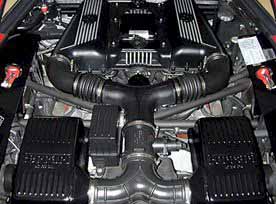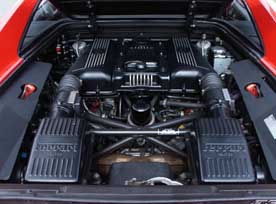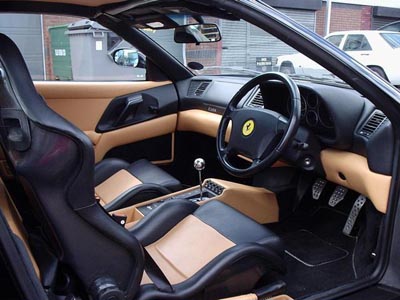The F355 was originally launched as a replacement to the 348 in 1994 with two models - the GTS and the Berlinetta. The Spider came a year later. This article describes the options that were available and the various special editions that were produced during the manufacturing period.
F1 Gearbox
In 1997, Ferrari launched the 355F1. The 'F' was dropped from the model designation for this model, presumably because F355F1 sounded a bit ridiculous. The F1 gearbox is not an automatic. It is a manual gearbox complete with clutch, which is hydraulically controlled such that moving either the up or down shift paddle carries out all of the same actions as in a manual car, except it is controlled by computer and is done in around 150ms. This produces astonishingly fast gearshifts, which although brilliant has been improved even further in 360 and 430 models.
Motronic Engine Management System
In 1996, Ferrari updated the engine management system and made some other subtle changes to the car. While doing your research you might find references to 2.7 and 5.2 cars, or even M2.7 and M5.2. This is a reference to the version number of the engine management system, which originally started out as 2.7 and was later upgraded to 5.2.
The 2.7 cars can be easily identified by looking at the airbox configuration in the engine bay. If you see a single inlet pipe, with the pipes from the two airboxes joining onto it, then you are looking at a 5.2 car. If you see two airboxes with separate inlet pipes, then you are looking at a 2.7 car. The 2.7 car has two separate mass air flow sensors - one for each bank of the engine, whereas the 5.2 car has only one - which is why the two airboxes feed into the same inlet pipe. In the pictures below, the 2.7 car is the first one.


2.7 cars are not bad cars in any way. In fact they are reputed to have 5-10 more horsepower than 5.2 cars, but it isn't anything you'd feel under your right foot.
Airbag
At the same time as the engine management system was upgraded, Ferrari also introduced both driver and passenger airbag. Unfortunately, in doing this they replaced the rather tasty steering wheel with a rather oversized affair. It is possible to revert to a smaller wheel but you'll lose the airbag.
355 Serie Fiorano
For the last 100 or so (reported by some to be the last 104 cars) Ferrari built the ultimate Spider. All cars came with a quicker steering rack, stiffer and lower suspension, wider track, drilled and ventilated discs, competition brake pads, and a stiffer anti-roll bar.
Asprey
Asprey (the Jewellers) were a sponsor of Ferrari and to celebrate this fact a small run of 5 cars were made, all in the same colour both inside and out. The exterior was Grigio Titanio (code 3240) which is a silver metallic, and the interior was a deep purple leather, which included the zone behind the seats. There were minor differences to the switchgear which was chrome plated in places. Matching luggage was also included.
Options List
You will find the following on some vehicles dependant upon what the original purchaser specified:
Airbag
At the same time as the engine management system was upgraded, Ferrari also introduced both driver and passenger airbag. Unfortunately, in doing this they replaced the rather tasty steering wheel with a rather oversized affair. It is possible to revert to a smaller wheel but you'll lose the airbag.
355 Serie Fiorano
For the last 100 or so (reported by some to be the last 104 cars) Ferrari built the ultimate Spider. All cars came with a quicker steering rack, stiffer and lower suspension, wider track, drilled and ventilated discs, competition brake pads, and a stiffer anti-roll bar.
Asprey
Asprey (the Jewellers) were a sponsor of Ferrari and to celebrate this fact a small run of 5 cars were made, all in the same colour both inside and out. The exterior was Grigio Titanio (code 3240) which is a silver metallic, and the interior was a deep purple leather, which included the zone behind the seats. There were minor differences to the switchgear which was chrome plated in places. Matching luggage was also included.
Options List
You will find the following on some vehicles dependant upon what the original purchaser specified:
-
F1 Gearbox (1997 onwards)
-
Matching color top (GTS). By default the targa panel would be black. You could have it painted the same colour as the body as an option. Most owners purchased this option.
-
Challenge grille. This is black mesh compared to the default body coloured solid panel.
-
Painted Brake Calipers (usually red; the standard is black).
-
Drilled Brake Discs
-
“Scuderia Ferrari” Shields recessed into the wings.
-
Fiorano handling pack. This is different to the serie Fiorano model as this was an option you could purchase long before this final run. The pack includes uprated suspension ECU and geometry, uprated brakes, and a quicker steering rack.
-
Carbon sports seats. These are simply stunning and not often specified.
-
Schedoni luggage. A three piece set, although if the spare wheel is purchased only two pieces can be fitted in the car.
-
Spare wheel w/jack (a space saver wheel).
-
Battery charger.
-
Carbon fiber interior trim pieces. There are a lot of aftermarket carbon interior parts, but apparently there were some factory carbon options which were hardly ever specified.

Carbon seats were a very expensive option at around £4000, but look fantastic and are great for spirited driving.
Page 2 of 7

